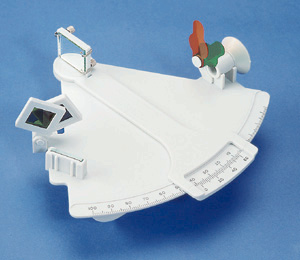This is a handheld GPS receiver.
For $115 brand new, it will consistently give you latitude, longitude, altitude and time. From this it can interpolate your course and speed over ground. It fits easily in your pocket, uses two regular AA batteries and can interface with your laptop to drive various electronic charting programs. It's water proof, shock proof, simple and durable. For most of the things which could possibly cause this GPS to fail (other than dead batteries), the best backup is this:
Another hand-held GPS.
However, GPS is vulnerable to satellite failure (accidental or otherwise) and solar storms. On a small boat, especially a small sailboat, it is most vulnerable to lightning strikes. The electromagnetic pulse from even a near-miss can fry all of your electronics, whether or not they are grounded into the keel. The best completely non-electronic alternative to GPS is this
plus this
$1700 for the sextant (a Tamaya Jupiter) plus $300 for the Seiko mechanical chronometer gets us to an even $2000. Add in another $380 for
for your routine celestial navigation before the lightning strike. Throw in another $120 for almanacs, full sight-reduction tables, plotting sheets and plotting tools for after the lightning strike, and that gets us up to around $2500. As a backup for a $115 GPS. For that price I could buy 20 GPS receivers and batteries to last until the satellites all fall out of the sky.
This, obviously, doesn't work.
In order for my celestial to be a meaningful backup to my GPS, it can't cost a lot more than my GPS.
So, let's try this again.
A sextant like this
costs $50.
A Nautical Almanac, complete with the NAO/Davies sight reduction tables, costs $30.
Quartz watches are amazingly accurate and dirt-cheap, but just as vulnerable to lightning strikes as any other piece of electronics. Mechanical chronometers are beautiful but three or more times the cost of a GPS. That leaves us with a simple but sturdy military-style mechanical watch
which is arguably the weakest link in the chain, also for about $30. This particular watch is a Chinese knock-off of a Vietnam era US Army MIL-W-0836F, but any mechanical watch will do. I'm presuming as a minimum that you have access to a time tick from WWV or WWVH, at least until the lightning strike. Throw in a set of dividers, a parallel rule and a pad of universal plotting sheets, and you're up to the cost of the GPS and its batteries.
Okay, so this is a cheap solution for equipping yourself for electronics-free celestial navigation. But will the equipment actually do the job? We're going to look at each of these "instruments" in turn over the next several days. I actually know the answer already for the sextant and the almanac with Davies tables. The wrist watch is a new element, which I have very recently acquired as a reward for safely navigating around the sun 47 times (thanks, brother- and sister-in-law, and proto-niece or nephew!).
Will begin tracking that tomorrow.





Happy birthday!
ReplyDeleteFor the non-navigators here, could you please give a simple explanation of how celestial navigation works?
ReplyDeleteI have gone through the site and read all blogs and this is a nice one:
GPS Gamma surveys
Great! This content is innovative, there are a lot of new concept,it gives me creativity.I think I will also motivated by you and think about more thoughts. office rework
ReplyDelete